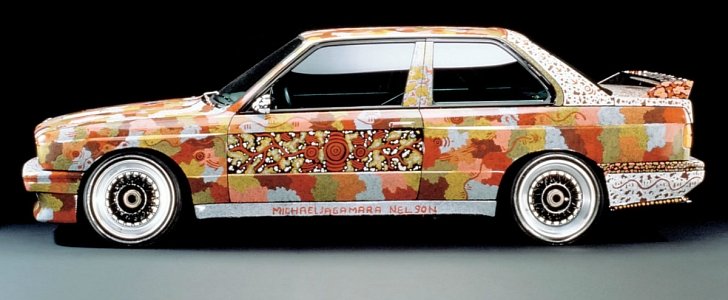The BMW Art Car project might’ve started as a daring endeavor back in the 1970s, but today it is much more than that, since it proves what can be achieved when massive amounts of passion are involved. Over the years, no less than 17 such cars have been created, and today we’re going to focus on number seven.
Back in 1989 the world was, once again, shaken to its core. Eastern European countries were rising, leaving communism behind and the URSS heading to its demise. The Iron Curtain finally fell and Germany was whole once again.
BMW seized the opportunity to celebrate, but it did so in a different way than you’d expect, by going to Australia. Over there, it asked Michael Jagamara Nelson to put his creative juices to work and bring to life another Art Car, this time using a BMW E30 M3 Group A car as his canvas.
As a matter of fact, the vehicle he painted was a full-on race version of the iconic model. As you can see in the video below, everything is there, from the single racing seat to the roll cage, to the aero parts and even the smaller side mirrors.
Michael needed seven days to complete his masterpiece, using Papunya Art in the process. This ancient method of painting was used by the aborigines, and it was taught from generation to generation of artists, as was the case here (Michael Jagamara Nelson learned it from his grandfather).
The car was therefore painted with mosaic-like Papunya paintings that symbolize landscapes and animals. Yes, we know it’s hard to see them all, but think of it as a metaphor, and then you’ll see what lies behind the apparent.
Speaking about his creation, Michael Jagamara Nelson said that “The car is a landscape as if viewed from an airplane - I have included water, the kangaroo, and the possum.” See, we didn’t make it up!
Leaving all jokes aside, Papunya art is indeed hard to read. Paintings made in this particular style can only be admired from an aerial view. They usually portray landscapes and feature diverse forms that symbolize water, caves, men and animals. To fully understand it, you need to study its history thoroughly first, which makes this Art Car, in our humble opinion, even more precious in the eyes of the onlookers.
BMW seized the opportunity to celebrate, but it did so in a different way than you’d expect, by going to Australia. Over there, it asked Michael Jagamara Nelson to put his creative juices to work and bring to life another Art Car, this time using a BMW E30 M3 Group A car as his canvas.
As a matter of fact, the vehicle he painted was a full-on race version of the iconic model. As you can see in the video below, everything is there, from the single racing seat to the roll cage, to the aero parts and even the smaller side mirrors.
Michael needed seven days to complete his masterpiece, using Papunya Art in the process. This ancient method of painting was used by the aborigines, and it was taught from generation to generation of artists, as was the case here (Michael Jagamara Nelson learned it from his grandfather).
The car was therefore painted with mosaic-like Papunya paintings that symbolize landscapes and animals. Yes, we know it’s hard to see them all, but think of it as a metaphor, and then you’ll see what lies behind the apparent.
Speaking about his creation, Michael Jagamara Nelson said that “The car is a landscape as if viewed from an airplane - I have included water, the kangaroo, and the possum.” See, we didn’t make it up!
Leaving all jokes aside, Papunya art is indeed hard to read. Paintings made in this particular style can only be admired from an aerial view. They usually portray landscapes and feature diverse forms that symbolize water, caves, men and animals. To fully understand it, you need to study its history thoroughly first, which makes this Art Car, in our humble opinion, even more precious in the eyes of the onlookers.

